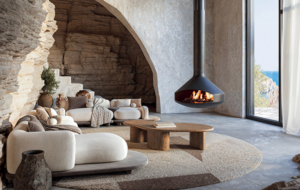
words Justin McGuirk
David Adjaye met Oscar Niemeyer while making a radio programme for the BBC on major figures in 20th-century architecture. Here, the young architect tells icon about it. The programme, which also includes Kenzo Tange, IM Pei and Moshe Safdie, airs in March.
So Niemeyer’s a hero of yours?
Without a doubt. First of all he’s a kind of black modernist. Not literally, but intellectually. Of course he’s of Portuguese descent but he’s also a complete mix, he has German and Afro genes, but he lives in the tropics and he’s from Salvador so he understands the black psyche, he comes from the black psyche. But also, for me, as a young architect searching for inspirational models and trying to break away from a Eurocentric image of what modern architecture could be, he was a kind of hope figure. He wasn’t one of the “I come from Europe and I’m going to teach you” modernists. He was “I live in the jungle and this is my interpretation of it”. That’s why I was intrigued by him and why I wanted to go meet him.
Where did you meet him?
At his studio, which is the most extraordinary place. Everything is white – white floors and white ceiling – and it overlooks Copacobana beach and the mountains of Rio. His offices aren’t there – his grunts are in another building – so he has this great set-up with a library and a dining room where we had lunch over the sea, and a couple of secretaries and advisers who sit in the corner. And he just does his work there and then rings up his architects to come and see it and take it away to the office.
I imagine him like Woody Allen at the typewriter, you know, drawing a couple of lines and then crumpling it up, then redrawing a couple of lines…
It’s quite interesting to see his drawings actually because when you get the perfect drawing that’s when the thing’s been realised. When you look at the evolutions of the Niteroi museum, the flying saucer, you realise this is a man who struggles for a long time before he finds the perfect form. The mythology that he just goes “whoo, and there you have it” is fictional. If you look at the Niteroi drawings there are struggles going through them. It’s like what I call a stammer. Shapes and lines and compositions are continually overlaid web-like or cluster-like and then he gets
this moment where suddenly a form appears and then he starts drawing that form.
Is he the greatest living architect?
Absolutely, because he superseded them all, the other two 20th-century greats being Le Corbusier and Mies. If Corb sets down a new discourse of modernity, Mies makes an elegant rendering of it, whereas Oscar sets up a new discourse of form-making. He’s the grandfather of the form-makers – Gehry and Greg Lynn and all these characters. Oscar shifted modernist dogma into poetry.
But his form-making is man-made, more natural if you like.
Yes, because it comes from his hands, he’s an artist in the truest sense, he’s a true artist-architect in the sense that it’s all about the sophistication of his subconscious mind and his hand, pre-computers. We talk about the “blob” but that’s a totally disrespectful word for Oscar’s forms. There’s extraordinary sensuality and lyricism in a plastic medium, way above what Corb was trying to do. Corb was just trying to bend a wall – this man is three-dimensionally sculpting forms. It’s almost baroque. He cites the palace in Saint Mark’s square in Venice as the key model for him, the idea of columns being perforated and matter being dissolved.
What about the other aspects of the job, beyond form?
What was really interesting in asking Oscar about the meaning behind his work – or trying to, because he hates those kinds of questions – is that he doesn’t disregard function; he totally understands it, but he doesn’t see architecture as being able
to solve society’s problems, or being able in any way to emancipate humanity. He sees this as the fundamental flaw of the modernists because they believed architecture could cure society’s ills, whereas Oscar believes only people can cure people’s ills. He’s a communist because he believes the agency of change is the will of people. He sees architecture like music, it is an inspiration only, and he tries to bring a transcendant moment into their experience of the everyday. If you want to be Catholic about it, Oscar is grace. Oscar is that moment of “don’t worry, it’s okay, be happy, enjoy your life”. I mean… thank you.
Whenever I’ve seen him interviewed he’s seemed so calm and soft-spoken but he’s clearly extremely wilful…
He’s soft-spoken but forceful, and it was incredibly difficult to interview him in that traditional sense because in a way he has his views and what you get is just complete affirmation of those, there is no exploration of other agendas. But I’m intrigued because once an architect decides his work is about a kind of inspiration he moves into the level of a composer, like a composer makes music to inspire not to do anything else. So the idea of judging Oscar as a wilful architect is difficult because the criteria he sets himself are not those of a social problem solver. He makes architecture to sing. And by that brief how do you criticise him?
Brazilians evidently revere him, does he come across as a man who knows it?
Well, they revere him and hate him. Niemeyer has the equivalent presence that Picasso had on the Parisian art scene, you know, he’s just lived too long for Brazilians. So they love him but they want to put him in the cupboard of history. But he’s not going away, this is not a frail man – I wouldn’t be surprised if he lives another ten years. He’s like this shadow that just will not go away.
You mean to younger generations of architects.
Yeah, who are dying to have their own voice. But anyway, he knows that he’s an icon – there are streets named after him. I mean he’s very modest but I think it’s very clear that he is part of the awakening of modern Brazil.
What did you learn from him?
Well what became very clear was to keep the conviction of our ideas and not to be somebody who’s moved by consensus. Because this is a man who did that and now he’s being celebrated for his beliefs. And this is an incredibly beautiful thing for me to see because really it started from nothing and it became the image of a country.
And what about what you said about not worrying too much? Is that a luxury he’s had that perhaps you don’t?
Well, I think one can find that luxury as an architect, one should try not to be overwhelmed by function. The real discourse of architecture is to find that beauty which gives people that magic tingle that they can’t quite understand.
What do you think he made of you?
Well, I showed him some of my work and he just giggled at me and said you have all your life to live. I’m very happy with that.


















